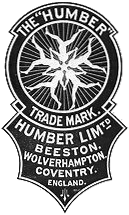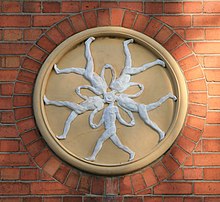
The Birmingham Small Arms Company Limited (BSA) was a major British industrial combine, a group of businesses manufacturing military and sporting firearms; bicycles; motorcycles; cars; buses and bodies; steel; iron castings; hand, power, and machine tools; coal cleaning and handling plants; sintered metals; and hard chrome process.

The penny-farthing, also known as a high wheel, high wheeler or ordinary, is an early type of bicycle. It was popular in the 1870s and 1880s, with its large front wheel providing high speeds and comfort.
Falcon Cycles is a British bicycle manufacturer which was based in Brigg, North Lincolnshire, owned by Tandem Group.

The Rootes Group or Rootes Motors Limited was a British automobile manufacturer and, separately, a major motor distributors and dealers business. Run from London's West End, the manufacturer was based in the Midlands and the distribution and dealers business in the south of England. In the decade beginning 1928 the Rootes brothers, William and Reginald, made prosperous by their very successful distribution and servicing business, were keen to enter manufacturing for closer control of the products they were selling. One brother has been termed the power unit, the other the steering and braking system.

Vehicles that have two wheels and require balancing by the rider date back to the early 19th century. The first means of transport making use of two wheels arranged consecutively, and thus the archetype of the bicycle, was the German draisine dating back to 1817. The term bicycle was coined in France in the 1860s, and the descriptive title "penny farthing", used to describe an "ordinary bicycle", is a 19th-century term.

Humber Limited was a British manufacturer of bicycles, motorcycles, and cars incorporated and listed on the stock exchange in 1887. It took the name "Humber & Co Limited" because of the high reputation of the products of one of the constituent businesses that had belonged to Thomas Humber. A financial reconstruction in 1899 transferred its business to Humber Limited.

Coventry Premier Limited owned a British car and cyclecar manufacturing business based in Coventry from 1912 to 1923. It changed its name from Premier Cycles to Coventry Premier Ltd in November 1914.
The Garrard & Blumfield or Blumfield & Garrard was an English electric car manufacturer from 1894 to 1896. The company is presumed to have been founded by C. R. Garrard and T. W. Blumfield.
The Hercules Cycle and Motor Company Limited was a British bicycle manufacturer founded on 9 September 1910 in Aston in England.

The Raleigh Bicycle Company is a British bicycle manufacturer based in Nottingham, England and founded by Woodhead and Angois in 1885. Using Raleigh as their brand name, it is one of the oldest bicycle companies in the world. After being acquired by Frank Bowden in December 1888, it became The Raleigh Cycle Company, which was registered as a limited liability company in January 1889. By 1913, it was the largest bicycle manufacturing company in the world. From 1921 to 1935, Raleigh also produced motorcycles and three-wheel cars, leading to the formation of Reliant Motors. Raleigh bicycle is now a division of the Dutch corporation Accell.
The Sun Cycle & Fittings Co. Ltd. was an English manufacturer of motorcycles, mopeds and bicycles. The company was based in Aston, Birmingham.

Thomas Humber was a British engineer and cycle manufacturer who developed and patented a safety bicycle (1884) with a diamond-shaped frame and wheels of similar size. It became a pattern for subsequent machines. Humber made many other improvements to bicycles. About 1868 he founded Humber Cycles, the bicycle manufacturing business at Beeston, Nottinghamshire later owned by Humber & Co Limited.

Sir Harold Bowden, 2nd Baronet, GBE, was the chairman and chief executive of the Raleigh Bicycle Company and Sturmey-Archer Ltd from his father's death in 1921 until his own retirement in 1938. He also served as President of the British Cycle and Motor-Cycle Manufacturers and Trader Union, President of the Motor and Cycle Trades Benevolent Fund, and Chairman of the British Olympic Association for the 1932 Summer Olympic Games in Los Angeles.

Clément Cycles, La Société des Vélocipédes Clément, Clément & Cie was a French bicycle manufacturer that was founded by the industrial entrepreneur Adolphe Clément. From its beginnings as a bicycle repair shop in Bordeaux, through its establishment as a bicycle shop and workshop in Paris to its mass manufacture of a wide range of bicycles from the purpose built, state of the art factory at Levallois-Perret, Paris, the brand always combined advertising and marketing flair with quality products.

The Coventry Motor Company or CMC was a Coventry motor vehicle manufacturer established in early 1896 by H J Lawson's secretary Charles McRobie Turrell (1875-1923) as a subsidiary of Lawson's British Motor Syndicate.

The Great Horseless Carriage Company Limited was formed in May 1896 with a capital of £750,000 in shares of £10 each "of which £250,0000 was for working capital". The company was formed to carry on the horseless carriage industry in England and works with railway and canal adjoining were secured at Coventry. The rights that were purchased had little lasting value and after a number of financial reconstructions beginning in 1898 all activities were terminated by 1910.

The British Motor Syndicate Limited (BMS) was a company formed in November 1895 by company promoter and entrepreneur Harry John Lawson. Lawson's aim was to use BMS to raise funds from the public to establish a business with a monopoly on petrol-driven cars by acquiring as many patents as possible related to such vehicles from Gottlieb Daimler, his business associates, and other sources.
Carlton Cycles was a bicycle manufacturer based in Worksop, Nottinghamshire, England.
Thomas Charles Willis Pullinger CBE OBE OBK JP was an English automobile engineer. He began his career working with bicycles before the first cars were built. After working for Sunbeam and Humber, he helped expand the Scottish works of Arrol-Johnston, where he developed structured apprenticeship programmes and an engineering college for women.
Frederick Cooper, generally known as ‘Fred’ or ‘Freddie’, was an English professional racing cyclist and subsequently partner in a bicycle manufacturing business.



























